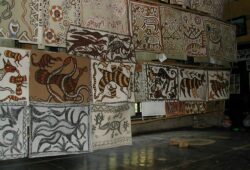Rice Paddy Art: Where Agriculture Meets Artistry
 Posted On
Posted On
In the heartland of Japan, where lush green rice fields stretch as far as the eye can see, a unique and mesmerizing form of artistry has emerged – Rice Paddy Art. This captivating blend of agriculture and creativity has become a symbol of harmony between nature and human ingenuity, attracting both locals and tourists alike. In this article, we will explore the origins, techniques, and cultural significance of Rice Paddy Art.
Origins of Rice Paddy Art
The roots of Rice Paddy Art can be traced back to a small village in the Aomori Prefecture of Japan, called Inakadate. In the early 1990s, local farmers were inspired to transform their rice fields into works of art after seeing crop circles in the UK and images of an intricate rice paddy artwork in China. Eager to create something unique, they embarked on a journey to merge agriculture and art.
Techniques and Process
Creating Rice Paddy Art is no small feat; it requires meticulous planning, teamwork, and a deep understanding of agriculture. The process typically begins in the winter months when a group of artists and farmers come together to brainstorm and design the artwork. These designs range from intricate patterns of animals, historical figures, and even famous paintings.
Once the design is finalized, the farmers plant different varieties of rice, each with its own unique color, to bring the artwork to life. By carefully selecting and arranging these rice varieties, they can create detailed and vibrant images. The timing of planting is crucial, as the various rice varieties grow at different rates, allowing the artwork to develop gradually.
To ensure the accuracy of their creation, the farmers use advanced technology, including GPS devices and computer software, to mark the planting locations precisely. As the rice plants grow, they require regular maintenance, including weeding and watering, to maintain the clarity and vibrancy of the design.
Cultural Significance
Rice has always held immense cultural significance in Japan, as it is a staple food and an integral part of the country’s heritage. Rice Paddy Art not only showcases the importance of rice cultivation but also honors Japan’s rich cultural traditions. Additionally, it promotes community engagement and pride among the local residents, who take great pride in their role as custodians of these magnificent living canvases.
Tourist Attraction
Rice Paddy Art has become a significant tourist attraction in Japan. Tourists from around the world flock to rural areas like Inakadate during the summer months to witness these breathtaking artworks. The fields are often best viewed from observation decks, which allow visitors to appreciate the artistry from an elevated perspective.
Beyond their visual appeal, these rice paddy artworks offer a unique opportunity for cultural exchange and education. Many visitors, both domestic and international, gain a deeper appreciation for the meticulous work that goes into rice cultivation and the harmony between man and nature.
Economic Impact
Rice Paddy Art has also had a positive economic impact on the communities where it is practiced. Local businesses, including hotels, restaurants, and souvenir shops, benefit from the influx of tourists seeking to experience this one-of-a-kind art form. This increased economic activity has helped support rural areas, contributing to their sustainability.
Environmental Awareness
Rice Paddy Art also serves as a reminder of the delicate balance between human activity and the environment. Farmers who practice this art form often use sustainable agricultural techniques to minimize their impact on the land and promote environmental stewardship. This serves as an example of how agriculture and art can coexist harmoniously while respecting the natural world.
Conclusion
Rice Paddy Art is a remarkable fusion of agriculture and artistry that has captivated the hearts and minds of people worldwide. Its origins in rural Japan exemplify the creative potential of communities coming together to celebrate their heritage and promote their culture. As a tourist attraction, economic booster, and symbol of environmental awareness, Rice Paddy Art stands as a testament to the power of human ingenuity and the enduring connection between people and the land they cultivate. This unique art form serves as a reminder of the importance of preserving cultural traditions while embracing innovation and sustainability in agriculture.



